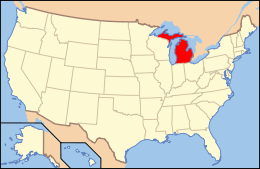National Register of Historic Places listings in Leelanau County, Michigan
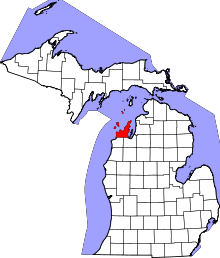
Location of Leelanau County in Michigan
This is a list of the National Register of Historic Places listings in Leelanau County, Michigan.
This is intended to be a complete list of the properties and districts on the National Register of Historic Places in Leelanau County, Michigan, United States. The locations of National Register properties and districts for which the latitude and longitude coordinates are included below, may be seen in a map.[1]
There are 22 properties and districts listed on the National Register in the county, including 1 National Historic Landmark.
- This National Park Service list is complete through NPS recent listings posted December 16, 2016.[2]
Listings county-wide
| [3] | Name on the Register[4] | Image | Date listed[5] | Location | City or town | Description |
|---|---|---|---|---|---|---|
| 1 | Bingham District No. 5 Schoolhouse |  |
(#91000353) |
Junction of County Roads 618 and 633 44°52′33″N 85°40′29″W / 44.875833°N 85.674722°W |
Bingham | This building was constructed in 1877 as a replacement for an earlier 1870 log school. It was used for first through eighth grade classes until school district consolidation after World War II. It is now the Bingham Township Hall. |
| 2 | Campbell-DeYoung Farm | 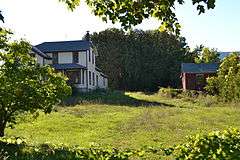 |
(#11000634) |
9510 E. Cherry Bend Rd. 44°48′32″N 85°39′18″W / 44.808889°N 85.655°W |
Elmwood Charter Township | This farmstead was first settled by Henry Campbell in 1855, who built the farmhouse in c. 1860. The Campbell constructed most of the buildings. It was owned by Louis DeYoung from 1925 until his death in 2004, and is now operated as a recreational area, the DeYoung Natural Area, by the Leelanau Conservancy. |
| 3 | Empire School | |
(#08000222) |
10017 W. Front St. 44°48′39″N 86°03′32″W / 44.810833°N 86.058889°W |
Empire | The Empire School was constructed in 1900-01 as a four-room schoolhouse. A gymnasium was added in 1932, and the school served the community until 1968. |
| 4 | Fountain Point | |
(#03000623) |
990 South Lake Leelanau Dr. 44°58′02″N 85°42′22″W / 44.967222°N 85.706111°W |
Suttons Bay Township | The name "Fountain Point" is derived from a fountain of sparkling artesian spring water, which has been continuously gushing since 1867. In 1889, Lydia Morrison of Cincinnati, Ohio. established "The Fountain Point House," a Victorian-style mansion, and guests began arriving for the summer by steamboat and buggy. |
| 5 | Glen Haven Village Historic District |  |
(#83000882) |
M-209 44°53′40″N 86°02′05″W / 44.894444°N 86.034722°W |
Glen Arbor Township | Glenn Haven is a restored logging village on the shore of Lake Michigan. Attractions include the restored General Store and Blacksmith Shop and the former Glen Haven Canning Co. building. |
| 6 | Grand Traverse Light Station | 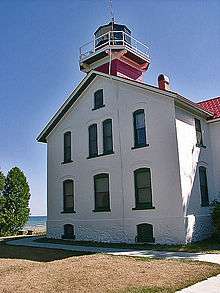 |
(#84001799) |
Leelanau Peninsula 45°12′38″N 85°32′58″W / 45.210556°N 85.549444°W |
Northport | The Grand Traverse Light was built in 1858, replacing a separate round tower built in 1852. The lighthouse is located inside Leelanau State Park. |
| 7 | Grove Hill New Mission Church |  |
(#72000631) |
On M-22 45°03′27″N 85°35′10″W / 45.0575°N 85.586111°W |
Omena | In 1852, Reverend Peter Dougherty moved his mission from what is now called Old Mission, Michigan to this location. He built a school, and, in 1858, this mission. Since 1925, it has been used primarily in the summer months, and is still open as the Omena Presbyterian Church. |
| 8 | Hutzler's Barn |  |
(#78000375) |
West of Leland on South Manitou Island 45°02′16″N 86°06′52″W / 45.037778°N 86.114444°W |
Glen Arbor Township | This barn was built in the 1870s by George Johann Hutzler, a German immigrant who staked his claim on South Manitou Island in 1863. |
| 9 | George Conrad Hutzler Farm | 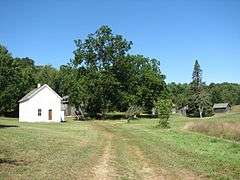 |
(#91000466) |
South Manitou Island, Sleeping Bear Dunes National Seashore 45°01′22″N 86°07′36″W / 45.022778°N 86.126667°W |
Glen Arbor Township | The George Conrad Hutzler Farm was established in 1870. George Conrad Hutzler Jr, the son of the original owner, was notable as an experimental former who was the first to experiment with hybridization of Rosen rye and Michelite pea beans. |
| 10 | Lake Leelanau Narrows Bridge |  |
(#99001732) |
M-204 over Lake Leelanau Narrows 44°58′53″N 85°42′42″W / 44.981389°N 85.711667°W |
Leland Township | This bridge, constructed in 1939, is the third bridge to cross this narrow section of Lake Leelanau. The bridge project was part of the Federal Emergency Administration of Public Works, which provided jobs in the Great Depression through funding public infrastructure projects. |
| 11 | Leelanau Transit Company Suttons Bay Depot |  |
(#97000929) |
101 S. Cedar St. 44°58′26″N 85°39′03″W / 44.973889°N 85.650833°W |
Suttons Bay | The railroad track through Suttons Bay in 1903 to access a Northport-Manistique car ferry. However, the railway was immediately unsuccessful and the ferry was discontinued by 1908. In 1919, a successor company, the Leelanau Transit Company was organized to take over ownership of the tracks. They leased built this depot in Suttons Bay as a passenger and freight station. |
| 12 | Leland Historic District | |
(#75000951) |
Roughly bounded by the park, Main St., Ave. A, and the harbor 45°01′24″N 85°45′40″W / 45.023333°N 85.761111°W |
Leland Township | This district, also known as Fishtown, contains Leland's harbor and surrounding area. The harbor contains fishing shanties, smokehouses, and docks established for the commercial fishing industry – some are still used for fishing, while others support the local tourism industry. |
| 13 | William and Margaret McFarland Core Farm |  |
(#04001579) |
5946 S. Center Hwy;5856 S. Lake Leelanau Dr. 44°53′40″N 85°41′02″W / 44.894444°N 85.683889°W |
Bingham Township | This farm, established in 1865, was operated by William Core and his descendants for nearly 150 years. It is currently operated as the Ruby Ellen Farm, a working farm open to the public. |
| 14 | Morgan-Copp-Mervau Building |  |
(#00000219) |
101 N. Mill St. 45°07′47″N 85°36′57″W / 45.129722°N 85.615833°W |
Northport | This building was built in three sections. The first, a single-story building fronting on Nagonaba, was constructed in 1880 as a grocery and dry goods store. An attached two-story section was built on the rear in 1881–83 as a home. The two-story section was extended to front onto Mill Street some time before 1905 and converted into a drugstore. A third section, built diagonally to front onto the Nagonaba/Mill intersection and featuring cedar stickwork, was built in 1927/28. |
| 15 | North Manitou Island Lifesaving Station |  |
(#98001191) |
East Coast, North Manitou Island 45°07′16″N 85°58′39″W / 45.121111°N 85.9775°W |
Leland Township | The North Manitou Island Lifesaving Station, also known as the North Manitou Coast Guard Station, is the only remaining station which was in use during all three periods of lifesaving service history, from the early volunteer period through operation by the United States Life-Saving Service and the United States Coast Guard. |
| 16 | North Manitou Shoal Light Station | .jpg) |
(#05000981) |
Northeastern Lake Michigan, approximately 3 mi (4.8 km) southeast of North Manitou Island 45°01′12″N 85°57′24″W / 45.02°N 85.956667°W |
Leland Township | The North Manitou Shoal Light Station was constructed to replace a lightship station in 1935. When it was automated in 1980, it was the last manned offshore light in the Great Lakes. |
| 17 | Port Oneida Rural Historic District |  |
(#97000563) |
Roughly bounded by Lake Michigan, Shell Lake, Bass Lake, and Tucker Lake 44°56′14″N 85°56′11″W / 44.937222°N 85.936389°W |
Cleveland and Glen Arbor Townships | The Port Oneida Rural Historic District consists of a set of farms that are typical of Northern European settlers throughout the Midwestern United States in the later part of the 19th century. The district is part of the is part of the Sleeping Bear Dunes National Lakeshore. |
| 18 | Riverside Inn | |
(#03000386) |
302 E. River St. 45°01′20″N 85°45′29″W / 45.022222°N 85.758056°W |
Leland Township | The first Riverside Inn was constructed in 1902 by Jacob Schwarz, who passed it to his daughters Blanche and Anna after his death. When the inn burned in 1924, Blanche and Anna reconstructed a nearby dancehall to make the current structure. The Riverside Inn is still in business, under owners Barb and Kate Vilter. |
| 19 | Saint Joseph's Catholic Church |  |
(#91001997) |
5899 County Road 669 44°53′40″N 85°53′00″W / 44.894444°N 85.883333°W |
Cleveland Township | Saint Joseph's Catholic Church was built in 1884 by Bohemian immigrants. The church was used by the Catholic congregation until 1970, when the Saint Joseph parish was merged with a neighboring one. |
| 20 | Sleeping Bear Inn |  |
(#79000284) |
M-209 44°54′15″N 86°01′38″W / 44.904167°N 86.027222°W |
Glen Arbor Township | This inn, originally called the "Sleeping Bear House," was built in 1857 by C.C. McCarthy. It operated as a boarding house and hotel through the rest of the 19th century, and well into the 20th. It eventually closed in 1973, and was purchased, along with the remainder of Glen Haven, by the National Park Service. |
| 21 | Sleeping Bear Point Life Saving Station |  |
(#79000285) |
North of Glen Haven 44°54′31″N 86°02′01″W / 44.908611°N 86.033611°W |
Glen Arbor Township | The Sleeping Bear Point Lifesaving Station is significant as a nearly intact version of what was, when built in 1901, a prototype architectural design. It is now a Maritime Museum and part of the Sleeping Bear Dunes National Lakeshore. |
| 22 | South Manitou Island Lighthouse Complex and Life Saving Station Historical District |  |
(#83003782) |
Sandy Point 45°00′34″N 86°05′35″W / 45.009444°N 86.093056°W |
Glen Arbor Township | This lighthouse, built in 1872, is the third built on the island, after earlier lighthouses constructed in 1840 and 1858 were deemed structurally deficient. The lighthouse was decommissioned in 1958, and is presently a museum. |
See also
| Wikimedia Commons has media related to National Register of Historic Places in Leelanau County, Michigan. |
- List of National Historic Landmarks in Michigan
- National Register of Historic Places listings in Michigan
- List of Michigan State Historic Sites in Leelanau County, Michigan
References
- ↑ The latitude and longitude information provided in this table was derived originally from the National Register Information System, which has been found to be fairly accurate for about 99% of listings. For about 1% of NRIS original coordinates, experience has shown that one or both coordinates are typos or otherwise extremely far off; some corrections may have been made. A more subtle problem causes many locations to be off by up to 150 yards, depending on location in the country: most NRIS coordinates were derived from tracing out latitude and longitudes off of USGS topographical quadrant maps created under the North American Datum of 1927, which differs from the current, highly accurate WGS84 GPS system used by most on-line maps. Chicago is about right, but NRIS longitudes in Washington are higher by about 4.5 seconds, and are lower by about 2.0 seconds in Maine. Latitudes differ by about 1.0 second in Florida. Some locations in this table may have been corrected to current GPS standards.
- ↑ "National Register of Historic Places: Weekly List Actions". National Park Service, United States Department of the Interior. Retrieved on December 16, 2016.
- ↑ Numbers represent an ordering by significant words. Various colorings, defined here, differentiate National Historic Landmarks and historic districts from other NRHP buildings, structures, sites or objects.
- ↑ National Park Service (2008-04-24). "National Register Information System". National Register of Historic Places. National Park Service.
- ↑ The eight-digit number below each date is the number assigned to each location in the National Register Information System database, which can be viewed by clicking the number.
This article is issued from Wikipedia - version of the 5/17/2016. The text is available under the Creative Commons Attribution/Share Alike but additional terms may apply for the media files.

